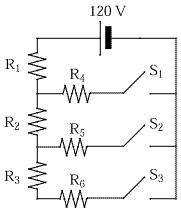- Joined
- Apr 9, 2008
- Messages
- 195
- Reaction score
- 0
R1 = R2 = R3 = R6 = 10 Ω, R4 = R5 = 20 Ω. Unless otherwise indicated, the battery can be assumed to be ideal (no internal resistance).

I'm wondering if someone can show me possibly an easier way on how to find the total resistance when all switches are closed.. We never did circuits in my physics class so sometimes these mess me up.. I'm hoping someone else looks at it a different way than the Kaplan explanation.. Thanks in advance.. The answer is 20 ohms.

I'm wondering if someone can show me possibly an easier way on how to find the total resistance when all switches are closed.. We never did circuits in my physics class so sometimes these mess me up.. I'm hoping someone else looks at it a different way than the Kaplan explanation.. Thanks in advance.. The answer is 20 ohms.
